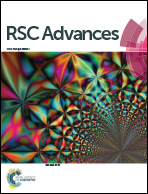Visible light triggered, catalyst free approach for the synthesis of thiazoles and imidazo[2,1-b]thiazoles in EtOH : H2O green medium†
Abstract
The development of a visible light promoted, mild and greener approach for the synthesis of highly functionalized thiazoles and imidazo[2,1-b]thiazoles under photochemical activation in EtOH : H2O green medium is demonstrated. The characteristic feature of the present protocol is the utilization of visible light (an omnipresent, nontoxic, environmentally benign and inexpensive reagent) to form C–S and C–N bonds and circumvent the use of catalysts or photosensitizers. The reported protocol is the first example of visible light promoted synthesis of thiazoles and imidazo[2,1-b]thiazoles with various attractive features like being catalyst free, eco-efficient and possessing cost effectiveness, short reaction time, excellent yields and sustainability to fulfill the parameters of green chemistry.
![Graphical abstract: Visible light triggered, catalyst free approach for the synthesis of thiazoles and imidazo[2,1-b]thiazoles in EtOH : H2O green medium](/en/Image/Get?imageInfo.ImageType=GA&imageInfo.ImageIdentifier.ManuscriptID=C6RA05385H&imageInfo.ImageIdentifier.Year=2016)

 Please wait while we load your content...
Please wait while we load your content...